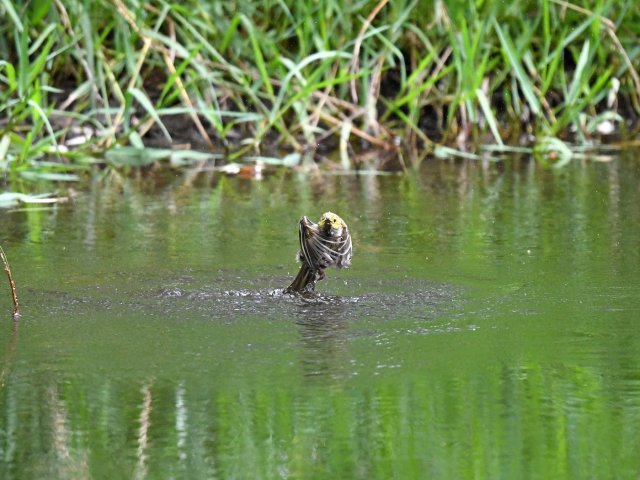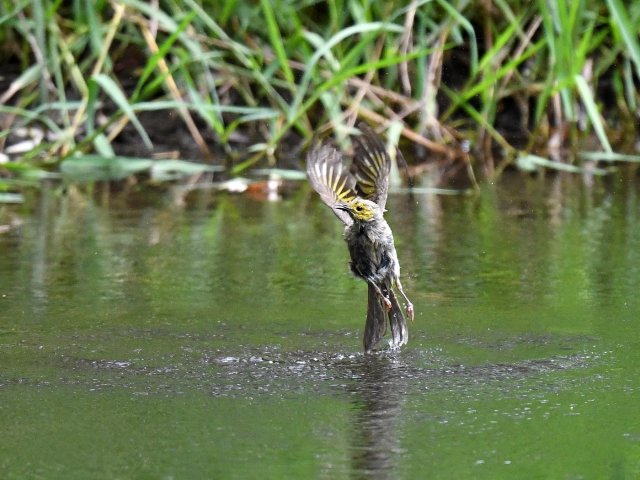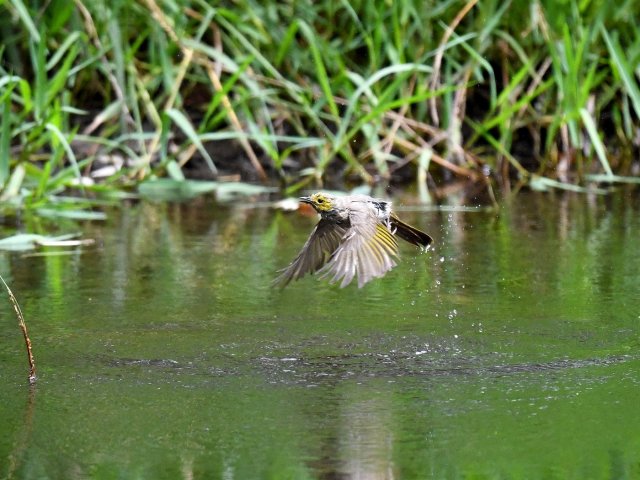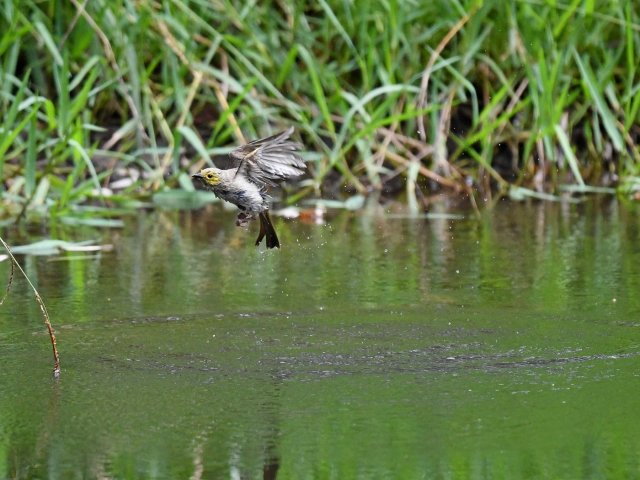I stopped at West Wyalong Wetlands recently, and it was alive with little White-plumed Honeyeaters, chasing each other through the trees. Then I found them at a still pool, bathing on the wing. They would perch on a tree branch, psych themselves up, then launch over the pond, splashing down in the middle and bouncing right out again as a bedraggled ball. Then sit in the sun for a bit, play a bit of chasey with their mates, and come back for more.
It was hard to photograph - I couldn't get too near, they are very small and fast, the light in the forest was green and cool. But I cranked up the ISO and gave it a go - the results are very grainy, but quite fun :-) Enjoy this little sequence (shot wide open at f5.6, 1/3200th, ISO 2200)














And what the bird looks like when its dry. Prepping to go off his diving board :-)
Nice sequence Alex, bit surprised ISO 2200 is "cranked up". Some of my shots come back with ISO 12,800 (currently using auto iso), as I am struggling with setings in "manual" mode.
How would they come out with a bit of crooping? I like the background as you have posted them, but wonder if you lose much detail of the bird when cropped (just interested for personal reference).
I would be happy with all of those.
Thanks for posting.
Dale Huonville, Tasmania
Thanks Dale :-)
ISO - yes, for these shots, I was using Nikon D850 and Nikon 500mm F5.6PF lens. Shutter speed was critical, so I was shooting wie open and 1/3200th to freeze the very fast-moving birds. I let ISO free on auto - normally I'd limit it to reduce grain - and it ended up at 2200 for these shots. The D850 is very good at handling higher ISO - but even so, when you do a big crop like these shots, the grain is really noticeable, and stops them from being great shots. One of my plans this year is to experiment with Topaz - they make some de-noise products for post processing that apparently achieve great results.
Cropping - these are already big crops - I was shooting from 25-30m away so as not to disturb the birds - so these are about 20-25% of the original frames. The versions that you are looking at here are necessarily low-res due to site limitations - but even the full-res ones are pretty marginal, I wouldn't want to crop more, as it would simply show up the grain and focus flaws in the photos more. But it was mostly an aesthetic choice - I wanted to show the splash-rings on the water, and I think they really add to the story I'm trying to tell here.
I actually like a bit more space in a photo - the diving board photo for example, its hardly cropped at all, and I could have gone MUCH tighter. But I love the patterns on the bark, the darker background with the bird in the lmelight, and the way it shows the bird in its environment - they are tiny birds, and this photo gives a bit of sense of its scale.
I guess these choices are personal, and I'm still learning what works - so I'm always interested in comments and suggestions :-)
Thanks Alex for your detailed response. It is interesting reading, and some of which I may try to follow. My biggest problem once I get some settings sorted is focus - handheld, often I have a lovely focus on the branch, and the bird is fuzzy.
There is a birder here on the Tasmanian Bird Sightings FB page who uses Topaz, and to be honest his results are simply amazing, but like you, he has quality glass, and endless hours to practice. He swears by it (although I am only aware of this because I have met him). Like most, they don't publicise what post processing software is used, and I get that.
I tried Darktable for a while, it is free, but fairly complicated. My son uses Gimp, again free, but I can't get my head around that. Currently using Skylum Luminar, but haven't put out for the AI extras. So far, I find the biggest issue with post processing is the quality of the original image from the sensor, and that is something I need to work on. I refuse to use Photoshop or PS Lightroom, as they hold you to ransom with ongoing monthly subscription.
Again thanks for taking the time to reply.
Dale Huonville, Tasmania
Hah, yes, the hardest part is getting that good image on the sensor!
Re focus: a few things have helped me really reduce the number of out of focus shots I was getting.
I'm sure you know this, those are just some of the things that helped me. I still get a lot of out of focus images - but a great deal less than I used to :-)
Thanks again, think I just need more time to practice.
Dale Huonville, Tasmania
Great set of shots, Alex and I also choose to leave more background at times as it tells the story. I used to crop close but decided that was not always the best. I took on DxO (3 year subscription) on a great deal some time ago because of the noise filter but Topaz looks good with some decent reviews.
Dale, there are ways to check if your focal point is a bit off and calibrate the camera body to that lens but I'm no expert. Might be worth a check or clean and recalibration sometime. I do it every year or so as maintenance because we go dusty places quite often. I am also now taking to using the tripod more as I often have the lens fully extended and it only takes the tiniest bit of movement to ruin the shot. Hope that is of some help.